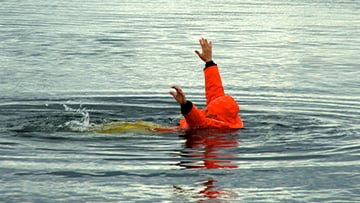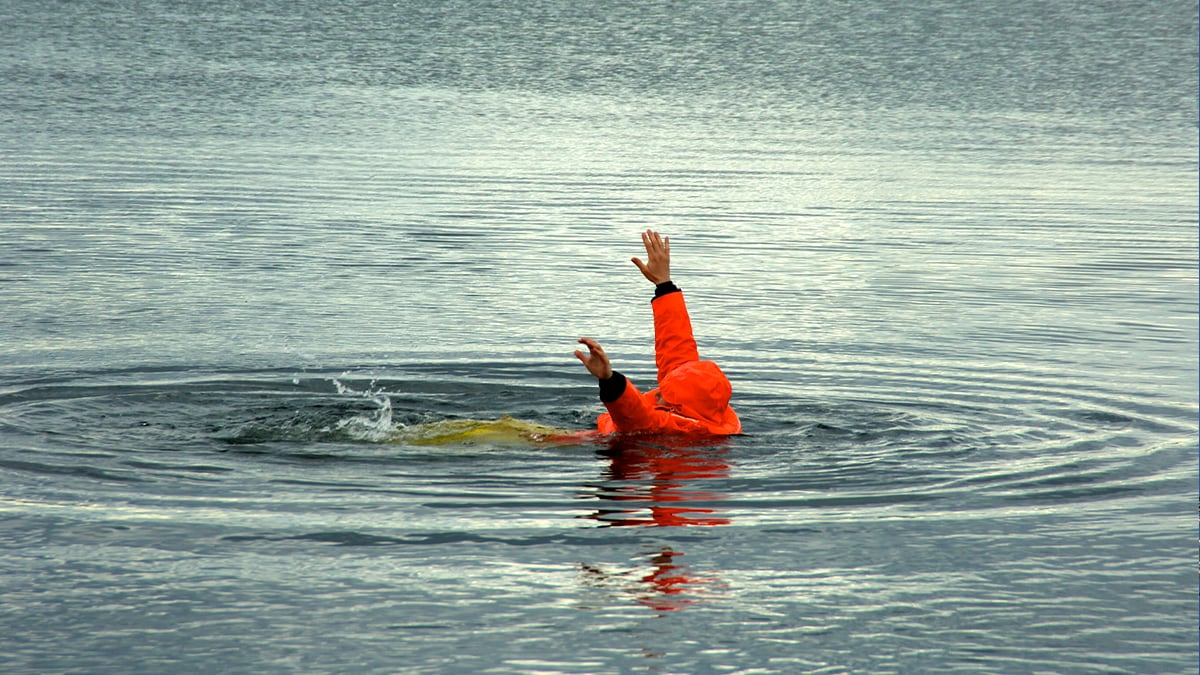Key points
- Falls overboard are the second leading contributor to fatalities among commercial fishermen nationwide.
- The most important step a person can take to survive a fall overboard is to wear a personal flotation device (PFD).
- Fall overboard incidents are survivable, but there are a number of actions that need to be taken by the victim and rescuers to make survival more likely.

Overview

- 266 fishermen died from falls overboard, representing 30% of all fatalities.
- None of the victims were wearing a functional personal flotation device (PFD) when they died.
- About 57% of falls overboard were not witnessed, usually due to the person working alone on deck or vessel.
- Fatal falls overboard most commonly occurred in the Gulf of Mexico shrimp, Alaska salmon, and East Coast lobster fisheries.
NIOSH has studied characteristics of fatal falls overboard and the use of PFDs in the fishing industry.
What is being done
The NIOSH PFD Study
In 2008, NIOSH researchers began visiting fishing ports around Alaska to conduct a two-part research program to reduce fall overboard fatalities in commercial fishing. The first part of the study was a questionnaire designed to measure fishermen's perceptions of risk related to falls overboard. The second part of the project was an evaluation study of six modern PFDs designed to be worn by fishermen while working.
Over 200 fishermen in 4 different fishing vessel gear types were randomly assigned a PFD to wear for 30 days on deck with an identical evaluation form filled out after the first day and the last day. The results were published in two peer-reviewed scientific journals and as a series of fact sheets designed to help fishermen find a comfortable PFD to work in on deck.
NIOSH PFD Study Results
Worker satisfaction with personal flotation devices (PFDs) in the fishing industry: evaluations in actual use.
Gear-specific PFD Fact Sheets - In 2012, NIOSH released the results of their PFD evaluation study as a series of gear-specific fact sheets to help commercial fishermen choose a comfortable PFD based on feedback from other fishermen.
What you can do
Working on wet, pitching decks with moving lines and heavy gear poses fall overboard risks for fishermen. To reduce deaths from falls overboard:
- Wear a PFD on deck. Nationwide, none of the fishermen who died from falling overboard were wearing a properly-working PFD when they died. PFDs can keep fishermen afloat, giving the crew time for rescue.
- Use a man-overboard alarm system. Many falls overboard are not witnessed, delaying recovery time and reducing chances of survival. A man-overboard system will alert the crew that a fall overboard occurred, and a device with GPS capabilities can signal the fisherman's location to assist in search and recovery efforts.
- Add effective recovery devices and re-boarding ladders. A rescue sling or similar device is more effective than a life ring for bringing a crewmember back on the vessel. If you fish alone, a plan should be in place for you to re-board your vessel unassisted after a fall.
- Conduct man-overboard drills monthly. Recovery procedures should be practiced regularly to ensure all crewmembers are prepared to respond to a fall overboard.
Falls Overboard Recovery Process
Falls overboard incidents are survivable, but there are a number of actions that need to be taken by the victim and rescuers to make survival more likely. For more information on the steps below, please watch our video Man Overboard: Prevention and Recovery.
- Float – wear a PFD on deck at all times! Visit the gear-specific PFD fact sheets for more information on selecting a comfortable PFD.
- Signal/Notification – alert the skipper, crew, and/or nearby vessels about the man overboard (MOB) incident.
- Communication – maintain visual contact with the MOB.
- Mark the MOB location – throw life rings, buoys, totes, or marker lights to mark the spot. Input the spot into your GPS as well.
- Turn the vessel – return to the location where the crewman went into the water.
- Prepare a rescue swimmer – they can assist the victim in getting back onboard. Use an immersion suit and detachable tether.
- Approach the MOB victim carefully – maintain visual contract and a safe distance depending on conditions.
- Deploy a rescue device – throw a life ring, lower a sling, ladder, or other boarding devices to help them get back over the rail.
- Mechanical advantage – use a hydraulic hauler or simple block and tackle to help lift the MOB out of the water more easily.
Falling overboard in cold water
The most important step a person can take to survive a fall overboard is to wear a PFD. The ability to float provides a victim with more time to be rescued, even in cold water. A common misconception is that overboard victims die from hypothermia, but in reality, victims without flotation die from drowning after cold incapacitation (the loss of ability to coordinate movement needed for swimming).
The 1-10-1 principle can help you understand what happens when someone enters cold water.
1 – Cold shock. In the first minute following cold water immersion, you gasp and hyperventilate.
10 – Cold incapacitation. During the next 10 minutes, it becomes more difficult to use your hands, arms, and legs. Swimming failure and drowning can occur.
1 – Hypothermia. It can take about an hour before hypothermia sets in.
Wearing a PFD is the best way to make sure you buy yourself as much time as possible for recovery.
Resources
Recommended Commercial Fishing Safety Videos
Falls overboard are the second leading cause of death among commercial fishermen in the Unites States. Between 2000 and 2014 there were 210 fatal falls overboard in the United States and NONE of the victims were wearing a personal flotation device (PFD) when they drowned. This video tells Stan's story, who fell overboard setting pots at the start of Dungeness crab season in Oregon and how his PFD saved his life.
Man Overboard: Prevention and Recovery
Learn tips on preventing man overboard fatalities on fishing vessels and the steps in a proper MOB recovery. View this video on the NIOSH YouTube channel.
Paul Revere: A Story of Survival in Bristol Bay
A quick interview with two survivors of a skiff capsizing incident in Alaska. Learn how their PFDs extended their survival time and allowed them to rescue themselves. View this video on the NIOSH YouTube channel.
United States Coast Guard
The US Coast Guard provides training, educational materials, and dockside exams for commercial fishermen.
Alaska Marine Safety Education Association (AMSEA)
AMSEA provides effective hands-on marine safety courses to the commercial fishing industry in Alaska and in other regions of the United States.
North Pacific Fishing Vessel owners Association (NPFVOA)
NPFVOA provides hands-on marine safety training to commercial fishermen in the Pacific Northwest.
Cold Water Boot Camp
This training program, developed by the National Water Safety Congress, highlights the specific safety issues related to cold water immersion and its effects on people.
- NIOSH Commercial Fishing Incident Database (CFID)
- Three workers were wearing PFDs initially; however, one was pulled off during rescue efforts, one was an immersion suit worn during a recovery effort of another overboard crewmember, and one was a manually inflatable PFD that was not inflated.
